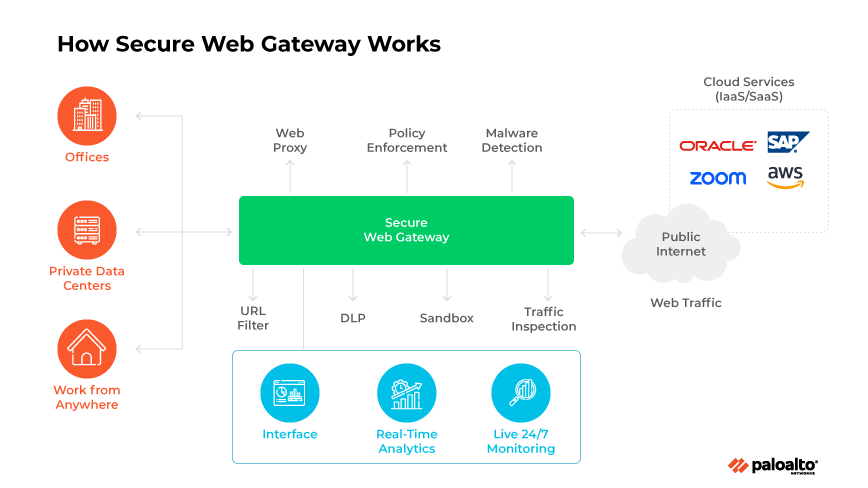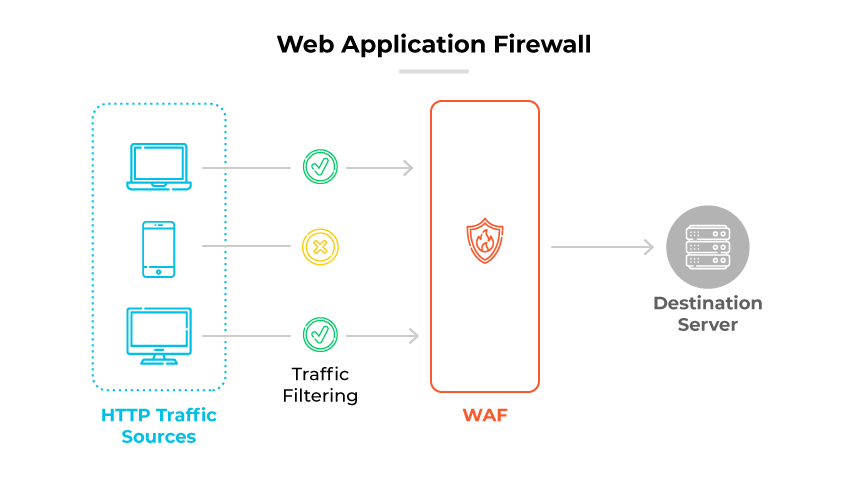Secure Web Gateway vs. WAF: What Is the Difference?

A web security gateway, also known as a secure web gateway or SWG, is a vital network security tool that manages network access and acts as an intermediary between users and the internet. It filters and monitors internet traffic to enforce corporate policies and protect against cyberthreats. Organizations deploy SWGs either on premises or in the cloud. Secure web gateways inspect outgoing web requests, authenticate users, and enforce security policies to ensure internet usage complies with organizational standards.
A SWG’s primary function is to provide a secure gateway for internet traffic, protecting against malicious websites, malware, and other cyberthreats. By filtering and inspecting web traffic in real time, SWGs can detect and block threats before they reach the end user's device. This helps organizations prevent attacks and data breaches, maintain compliance with regulatory requirements, and safeguard sensitive information.
SWGs play a crucial role in ensuring the security and integrity of an organization's network. They provide a comprehensive security solution that goes beyond basic network security by offering advanced features like URL filtering, application control, and antimalware protection. Additionally, SWGs can help organizations optimize network performance by caching frequently accessed web content and reducing bandwidth usage.
What Is a Secure Web Gateway (SWG)?
What Is a WAF?

A web application firewall (WAF) works by scrutinizing and filtering HTTP traffic to protect against threats like XSS, SQL injection, and file inclusion. WAFs are an essential defense for web applications, web servers, and APIs. They focus on Layer 7, specifically targeting application-level threats.
WAFs sit in front of web applications where they act as reverse proxies, intercepting and inspecting data packets to ensure only legitimate traffic reaches the application. A web application firewall uses access control to promptly block suspicious or malicious traffic, preventing potential attacks. This setup boosts web application security and shields applications from direct exposure to internet threats.
WAFs use policies or rule sets to differentiate between traffic that contains malicious code and benign traffic. Security analysts can adjust rules swiftly, allowing for immediate responses to emerging threats or evolving attack patterns. Regular rule updates are crucial for maintaining security.
Secure Web Gateway vs. Web Application Firewall: What Are the Differences?
| Differences Between WAF and Web Security Gateway | |
|---|---|
| SWG | WAF |
|
|
Purpose and Focus
A SWG primarily aims to filter unwanted software and internet traffic to enforce corporate and regulatory policy compliance. In contrast, a WAF focuses on protecting web applications from attacks by filtering and monitoring HTTP traffic.
Deployment
SWG deployment options include physical servers, cloud-based virtual machines, or software applications. SWGs sit between users and the internet. On the other hand, WAF deployment options include software, appliances, or as a service.
Key Features
SWG features typically include URL filtering, antimalware, application control, and threat prevention. WAFs offer protection against application-level attacks such as cross-site scripting (XSS), SQL injection, and cookie poisoning, with policy customization for meeting the unique needs of web applications.
Traffic Inspection Approach
SWGs inspect all outgoing and incoming web traffic, authenticating users and examining requests to ensure compliance with acceptable use policies. WAFs specifically inspect HTTP/S traffic to and from web applications, focusing on identifying and blocking malicious requests based on a set of defined policies.
Use Cases
SWGs safeguard organizations from web-based threats and enforce internet usage policies. WAFs protect web applications from targeted attacks and help maintain the security and integrity of sensitive data processed by these applications.
Secure Web Gateway vs. Web Application Firewall: What Are the Similarities?
| Web Security Gateway vs. Web Application Firewall: How Are They Similar? | |
|---|---|
|
Policy Enforcement
Both technologies enforce specific security policies. SWGs implement policies to ensure safe internet usage and compliance with regulatory requirements. WAFs apply policies to protect web applications from vulnerabilities and attacks like SQL injection and cross-site scripting.
Compliance and Data Protection
Both SWGs and WAFs play a role in helping organizations comply with regulatory standards and protect sensitive data. They provide mechanisms to prevent data breaches, safeguard against cyber threats, and ensure internet usage and web applications adhere to compliance requirements.
Adaptability to Threats
Modern SWG and WAF systems both adapt to new and evolving threats. They update filtering and monitoring mechanisms to respond to the latest security risks. Through updates to threat databases and the ability to implement new rules, both technologies remain relevant in a rapidly changing security environment.
Can SWG and WAF Work Together?
Secure web gateways and web application firewalls serve as essential elements in an organization's defense strategy. They complement each other by securing different segments of network traffic. SWGs inspect and filter all outbound and inbound web traffic, while WAFs shield web applications by filtering inbound HTTP traffic.
The Roles of SWG and WAF in SASE
SWG forms a core component of secure access service edge (SASE) by providing comprehensive web security. Its role is to block access to or from malicious websites and internet traffic, apply corporate and regulatory policy compliance, and prevent threats such as malware from reaching the network or endpoints. By operating at the network edge, SWGs can apply consistent security policies and data protection measures for all users, regardless of location.
WAFs are not an explicit component of SASE architecture, however, they naturally fit into the SASE framework because they focus on protecting web applications. In a SASE architecture, the role of WAF is to ensure the integrity and security of web applications that remote users access.
In the context of SASE, both SWGs and WAFs work to secure distinct aspects of an organization's internet facing infrastructure. Together, they offer a layered defense against a wide range of cyberthreats, crucial for protecting the dispersed resources and remote nature of today's enterprise environments.